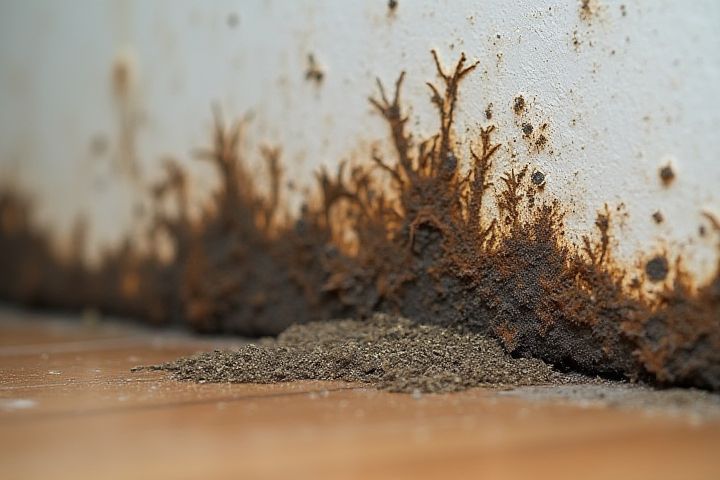
House mold primarily thrives in environments with high humidity, typically exceeding 60%. Insufficient ventilation in areas such as bathrooms, kitchens, and basements can create stagnant air, further exacerbating moisture accumulation. Water leaks from plumbing or roofing issues contribute significantly to mold growth by providing a constant source of moisture. Organic materials, including wood, drywall, and carpeting, serve as nutrient sources, allowing mold spores to thrive once they settle. To prevent mold in your home, it's essential to control humidity levels, ensure proper ventilation, and promptly address any leaks or moisture problems.
What Causes House Mold
Humidity levels
Humidity levels play a critical role in the growth of house mold, as they provide the necessary moisture that mold spores need to thrive. When indoor humidity exceeds 60%, it creates an ideal environment for mold to proliferate, particularly in areas like bathrooms, kitchens, and basements. This excess moisture often results from inadequate ventilation, water leaks, or cooking activities. To prevent mold growth, it's essential to monitor and control humidity levels, ideally keeping them between 30% to 50%.
Poor ventilation
Poor ventilation significantly contributes to house mold growth by trapping excess moisture and humidity indoors. When the air flow is limited, areas such as bathrooms, kitchens, and basements become breeding grounds for mold spores, which thrive in moist environments. Inadequate air circulation prevents the evaporation of water from surfaces, allowing dampness to persist and create ideal conditions for mold development. To mitigate mold risks, ensure your home has appropriate ventilation systems, such as exhaust fans and open windows, to promote fresh air exchange and reduce humidity levels.
Water leaks
Water leaks are a primary factor contributing to house mold formation, as mold thrives in damp environments. Even minor leaks from plumbing fixtures, roofs, or basements can create a conducive atmosphere for mold spores, increasing humidity levels. The Centers for Disease Control and Prevention (CDC) indicate that mold can begin to grow within 24 to 48 hours of water exposure, which makes timely repairs crucial. To prevent mold growth, it is essential to address leaks promptly and maintain indoor humidity levels below 50%.
Flooding
Flooding is a significant contributor to house mold growth, as it creates a damp environment ideal for mold spores to thrive. When water infiltrates your home, it can saturate materials like wood, drywall, and carpets, promoting mold proliferation within 24 to 48 hours if not addressed. The humidity levels in a flooded area often rise above 60%, further exacerbating the issue. Implementing prompt water removal and dehumidification is critical in preventing extensive mold damage and ensuring your living space remains safe and healthy.
Condensation
Condensation occurs when warm, moisture-laden air cools and loses its ability to hold water vapor, resulting in moisture settling on surfaces. This often happens in areas with poor ventilation, such as bathrooms and kitchens, where warm, humid air can accumulate. When surfaces like walls, windows, and ceilings remain damp, mold spores can thrive, leading to harmful growth. To prevent house mold, it's essential to control humidity levels through proper ventilation and maintaining a consistent indoor temperature.
Damp basements
Damp basements create the perfect environment for house mold to thrive, primarily due to high humidity levels that often exceed 60%. Water intrusion from leaks, poor drainage, or rising groundwater can exacerbate these conditions, leading to mold growth on surfaces like walls and floors. If your basement lacks proper ventilation, the stagnant air further contributes to moisture buildup, promoting fungal spores' proliferation. Regularly monitoring and controlling humidity levels, ideally keeping them below 50%, is essential for preventing mold and ensuring a healthy home environment.
Roof damage
Roof damage is a primary contributor to house mold, as it can lead to water infiltration and increased humidity levels indoors. When shingles are cracked or missing, or when flashing is improperly installed, moisture can enter your attic and living spaces, creating an ideal environment for mold growth. Studies indicate that mold can begin to develop within 24 to 48 hours following water exposure, emphasizing the urgency of addressing roof issues promptly. Regular inspections and timely repairs can significantly reduce mold risk, protecting your home's structural integrity and air quality.
Plumbing issues
Plumbing issues are a significant contributor to house mold growth, primarily due to water damage from leaks or poorly maintained pipes. For example, a leaking faucet can drip up to 30 gallons of water monthly, creating a damp environment ideal for mold spores to thrive. Furthermore, damaged sewer pipes can lead to sewage backups, releasing moisture and contaminants that exacerbate mold proliferation. Regular inspections and prompt repairs of plumbing systems can mitigate moisture accumulation, protecting your home from potential mold infestations.
Wet clothing indoors
Wet clothing indoors can significantly contribute to house mold, as moisture provides an ideal environment for mold spores to thrive. When clothes are left damp, they release humidity into the air, raising indoor relative humidity levels to over 60%, which is conducive to mold growth. Storing wet laundry in enclosed spaces like laundry rooms or bedrooms exacerbates the issue by restricting airflow and preventing proper drying. To mitigate mold risk, always dry wet clothing outdoors or use a dryer to keep humidity levels in your home below 50%.
Inadequate insulation
Inadequate insulation can significantly contribute to house mold growth by allowing temperature fluctuations and moisture buildup within walls and ceilings. Poorly insulated areas experience condensation when warm air meets cold surfaces, creating an ideal environment for mold spores to thrive. Insufficient sealing around windows, doors, or electrical outlets further exacerbates this issue, facilitating air leaks that introduce humid outdoor air. Maintaining proper insulation levels is crucial; homes with R-values below recommended thresholds are more susceptible to moisture problems that lead to mold infestations.
